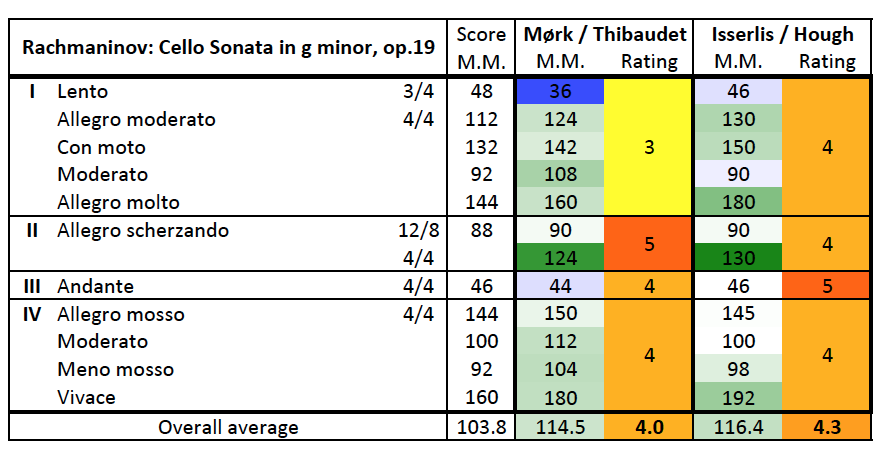Sergei Rachmaninoff
Sonata for Cello and Piano in G minor, op.19
Media Review / Comparison
2014-08-29 — Original posting (on Blogger)
2014-09-16 — Added link to review for concert on 2014-09-14
2014-11-03 — Re-posting as is (WordPress)
2016-07-24 — Brushed up for better readability
Table of Contents
Introduction / The Recordings
This posting is about the Sonata for Cello and Piano in G minor, op.19 by Sergei Rachmaninoff (1873 – 1943). I currently have two recordings:
I purchased these recordings as a follow on a concert in London’s Wigmore Hall, about which I wrote in the posting Han-Na Chang & Finghin Collins, 2012-04-28. Later, I have written a brief review about these two recordings when discussing the two CDs in my Listening Diary 2012-07-30. Now, as part of a preparation for an upcoming concert visit, I want to revisit the above two recordings in my collection by discussing the cello sonata in a more detail.
Background, About the Composition
In 1901, one year after the completion of his second piano concerto, Sergei Rachmaninoff (1873 – 1943) finished his Sonata for Cello and Piano in G minor, op.19; the first performance was in the same year, with the composer at the piano, and with Anatoliy Brandukov (1859 – 1930), the dedicatee of the composition, at the cello. This is a highly romantic composition, now a part of the standard cello repertoire. In the early 20th century, however, it was largely overshadowed by the success of the second piano concerto.
The Movements
With its four movements, the sonata still follows the classic / romantic scheme:
I. Lento — Allegro moderato
Annotation: Lento, 3/4 (1/4 = 48) — Allegro moderato, 4/4 (1/4 = 112) — Con moto (1/4 = 132) — Moderato (1/4 = 92) — Allegro molto (1/4 = 144)
The Allegro moderato part, up to an including the Moderato section, is between repeat signs. This gives the impression of a standard, classical sonata form. The part that follows has properties of an development section. It works with themes and motifs from the first part. However a real recapitulation section is missing. The piece keeps evolving up to the somewhat abrupt ff ending. Also harmonically the movement is far from the classic scheme.
II. Allegro scherzando
Annotation: Allegro scherzando, 12/8 (3/4 = 88) — 4/4 (3/4 = 1/2) — 12/8 (1/2 = 3/4)
A rhythmically demanding, virtuosic, fairly intricate movement, with a singing, expressive middle part in 4/4. The outer parts are mostly p … mf, with some strong f, sf, and ff outbursts
III. Andante
Annotation: Andante, 4/4 (1/4 = 46)
The slow movement starts like a both serene and very melancholic song without words, with the piano alone — for me, one of Rachmaninoff’s most beautiful and intense inventions, with long phrases building up to impressive (& expressive) climaxes.
IV. Allegro mosso
Annotation: Allegro mosso, 4/4 (1/4 = 144) — Moderato (1/4 = 100) — Tempo I — Meno mosso (1/4 = 92) — Tempo I — Moderato — Più vivo — Meno mosso — Vivace (1/4 = 160)
The piano part in the last, Rondo-like movement is again very virtuosic, often polyrhythmic; the cello mostly retains its “vocal” character, often in a dialog with the pianist, with a beautiful melody / vocal theme. At the same time, the movement is very multi-faceted, with frequent tempo changes. What dominates is the exuberant, joyful and brilliant character in the returning Allegro mosso parts, in the end accelerated to a jubilant Vivace.
The Interpretations, Overview
In order to provide a rating overview, as well as an idea about tempo relations both within an interpretation, as well as between the two recordings, I have prepared the little table below:
Note that the color coding for the tempo (blue = slower, green = faster) refer (i.e., indicate differences) to the metronome annotations in the score. The measured metronome values are rough estimates, given the strong rubato in some of the interpretations. Rating values are between 1 (bad) and 5 (excellent).
The Interpretations, Detail
The two interpretations presented below are quite different in many ways. Upon re-listening, however, my judgement is a little less clear-cut than two years ago, in my Listening Diary 2012-07-30:
Truls Mørk & Jean-Yves Thibaudet
Sergej Rachmaninoff: Cello Sonata in G minor, op.19; 2 Pieces for Cello and Piano, op.2
Nikolai Myaskovsky: Cello Sonata No.1 in D, op.12
Truls Mørk & Jean-Yves Thibaudet
Virgin classics 5 45119 2 (CD, stereo); ℗ / © 1996
Booklet 31 pp., e/d/f

Truls Mørk (*1961) and Jean-Yves Thibaudet (*1961) recorded this sonata in 1994. The sound of their recording is rather compact (the cello tends to dominate), with limited transparency in the piano part. Truls Mørk tends towards f or ff, and a dense tone with also a dense (fast rather than slow & heavy) vibrato. These are properties that I can in principle accept for this music. However, sometimes the vibrato is a bit on the strong side for my taste.
I. Lento — Allegro moderato
Duration: 13’11”
In this interpretation, the Lento introduction is very slow, essentially senza tempo. It’s substantially below the composer’s annotation. But on the other hand, the writing of most of the introduction is such that the listener doesn’t have a sense of rhythm, except for the last part of that section. The introduction already exemplifies a characteristic of this entire recording: the tendency to push the dynamics towards f up to ff. I don’t think that’s just the sound engineer: in bars 8 and 11, Rachmaninoff writes mf. The cellist plays f at least, if not ff. To me, the piano lacks transparency and clarity, maybe also differentiation in articulation and dynamics (such as the differentiation between melody voices and accompaniment). The repeat of the “exposition” is observed.
II. Allegro scherzando
Duration: 6’13”
In the outer parts, this interpretation highlights the dark, sometimes almost ghastly atmosphere. That is probably reinforced by the sound management which may push the basses a bit too far, at least for the cello. This makes the singing cello stand out even more in the (un poco) meno mosso segments, and even more so, the central 4/4 section appears bright, expressive, singing. On the downside, those “dark” sections are meant to be mostly pp and p, which they aren’t.
III. Andante
Duration: 6’13”
Excellent build-up to the climax in these long phrases, strong and intense, highly romantic, expressive: definitely a good interpretation.
IV. Allegro mosso
Duration: 10’08”
Almost boisterous, maybe a bit too loud sometimes (once more)? It’s virtuosic in the wild parts, nicely singing in the more lyrical / expressive parts: definitely not a bad interpretation. A little more transparency and focus on dialogs with melody lines in the piano part would have made it even better.
Overall Duration: 35’43”
Rating (see above for details): 4.0 — A good interpretation, maybe sometimes a bit too gross / dense / loud.
Steven Isserlis & Stephen Hough
Sergej Rachmaninoff: Cello Sonata in G minor, op.19; 2 Pieces for Cello and Piano, op.2
César Franck: Cello Sonata in A; 2 Lieder (*) “Le Sylphe” and “Panis Angelicus”
Steven Isserlis & Stephen Hough (*: with Rebecca Evans)
Hyperion CDA67376 (CD, stereo); ℗ 2003
Booklet 16 pp., e/f/d

Steven Isserlis (*1958) and Stephen Hough (*1961) recorded the Rachmaninoff sonata in 2002. One could view this recording as the opposite to the one by Mørk and Thibaudet: where these tend towards density, intensity, and f / ff, Isserlis and Hough tend towards clarity, transparency, subtlety, maybe even elegance. This happens at the expense of passages where Rachmaninoff really does ask for f or ff, see below. In a way, where Mørk / Thibaudet try to be spectacular / to show off Isserlis & Hough are in danger of appearing inconspicuous.
The sound is transparent, fairly balanced, though there are times where the piano is close to covering the cello part. But in general, the cellist’s sound and expression are excellent, the vibrato natural, never irritating, the articulation clear. Overall, these artists appear to take the “classic” (rather than a late romantic) approach to this music. With this, I think, they may be missing some of the intended scope of expression.
I. Lento — Allegro moderato
Duration: 9’51”
The tempo in the introduction follows the score. Also the dynamics are correct and not pushed, as in Mørk’s recording. Stephen Hough’s strength is in the lyrical parts, such as in the piano soli in the two Moderato sections. His playing is very differentiated, expressive, full of poetry and exquisite agogics. I like the way in which he can make melodies sing!
In general, his playing is impeccable, he has no problem at all with virtuosic passages. If only he would dare to play a real ff: Rachmaninoff’s music is more than just romantic, it also has these extroverted “power moments”. Without these, his music is in danger of becoming too romantic. The liner notes give no explanations to why the “exposition” is not repeated. Maybe the artists found that it’s not a proper sonata form anyway, and the repeat only obscures the evolution within the movement?
II. Allegro scherzando
Duration: 6’16”
Here, the artists really observe the p and pp annotations. But then, the rough(er) aspects, such as the ff outbursts are mostly ignored. The “dark” parts are too light & subtle, ff is f at best, the martelato that leads back from the 4/4 section to the 12/8 rhythm is not hammered at all: it is much too tame, too legato! The main drawback of this approach is that the contrast to the middle section is lost. One last point: I don’t think it’s just my imagination, but with the first entries of the cello (in that ghastly, dark part) I sense a tad “defensive timing”. That’s hard to nail down, but I think the cellist is a tiny amount late in these rhythmically tricky entries — enough for a slight irritation.
III. Andante
Duration: 6’07”
As expected, much more subtle: the same build-up as with Mørk / Thibaudet, but all (at least) one level less extroverted and loud. Much more differentiated in both parts. Stephen Hough at his best, with wonderfully singing melody lines, detailed articulation: very emotional. Not exuberant, but with very intimate moments.
IV. Allegro mosso
Duration: 10’29”
In comparison to Mørk / Thibaudet, this recording is more transparent and more differentiated. Hough articulates very carefully and watches out for melody lines in the complex piano part, and there is excellent interplay between the two artists, through decent agogics.
The artists properly observe dynamic annotations. There is one explicit exception: as explained in the liner notes, the last Meno mosso prior to the final Vivace does not start pp, but ff. Steven Isserlis’ grandfather (a pianist) was apparently playing that sonata with the dedicatee of the composition, Anatoliy Brandukov. The latter stated that after publishing this composition, Rachmaninoff changed his mind, wanting that section to start ff. Because there were no follow-up editions so far, this change has never shown up in print. Isserlis states that this modification makes sense. I must agree, at least for the dramaturgy of their interpretation.
The one minor criticism I have is that with the subtlety of the pp parts, the interpretation is sometimes in danger of losing drive in this movement. In General, it lacks the stormy, enthralling character of the recording with Mørk / Thibaudet.
Overall Duration: 32’42”
Rating (see above for details): 4.3 — Another, very good interpretation, for which I have a slight preference among the two in this review.
Addendum
Rachmaninoff’s Sonata for Cello and Piano in G minor, op.19 was featured in a chamber music concert at the Tonhalle in Zurich, with Yuja Wang and Thomas Grossenbacher. See my concert review in the posting “Yuja Wang, Tonhalle Zurich, 2014-09-14“.







